Building for Growth: Supporting Gender-Specific Needs in Middle School Design
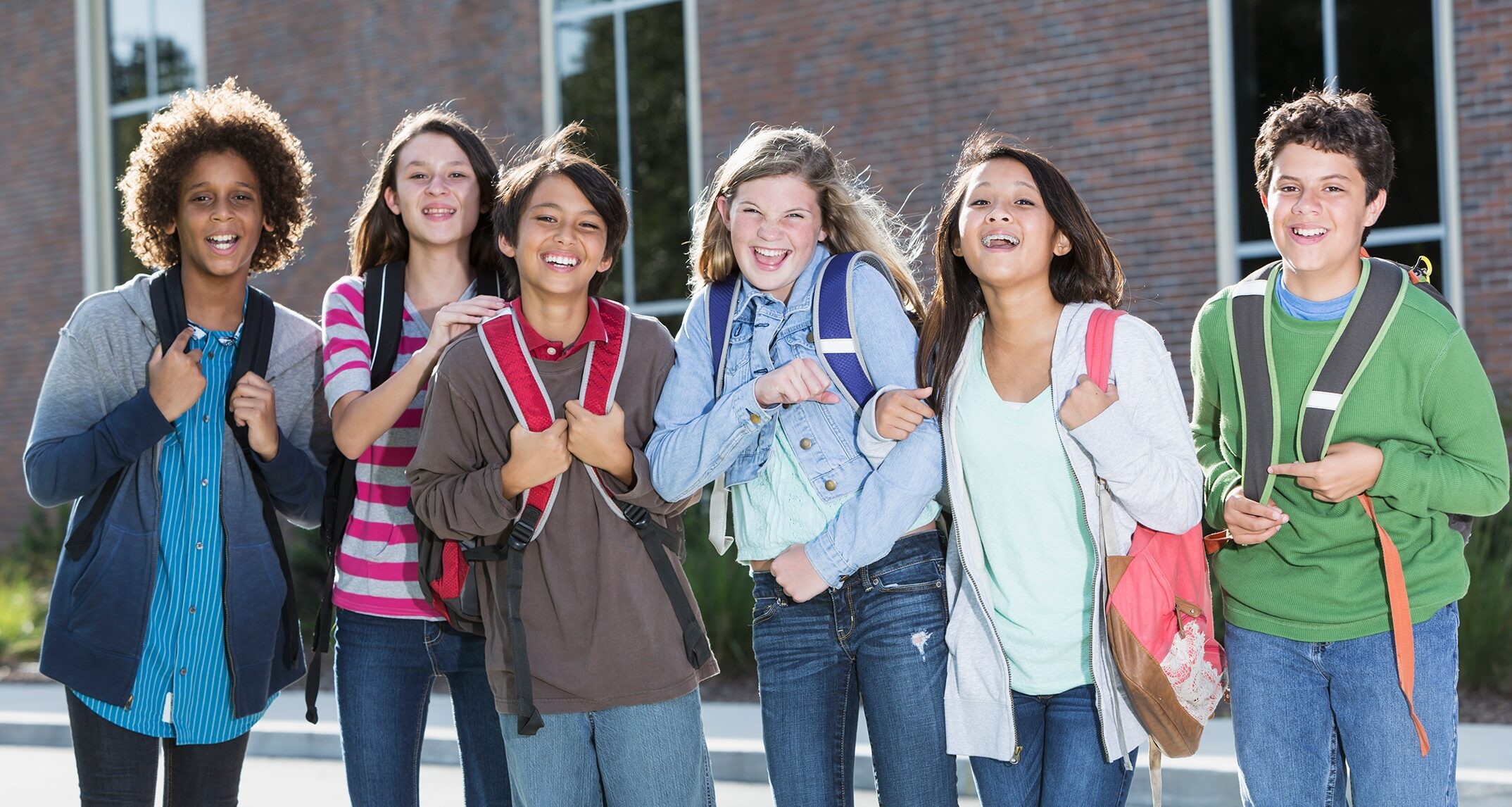
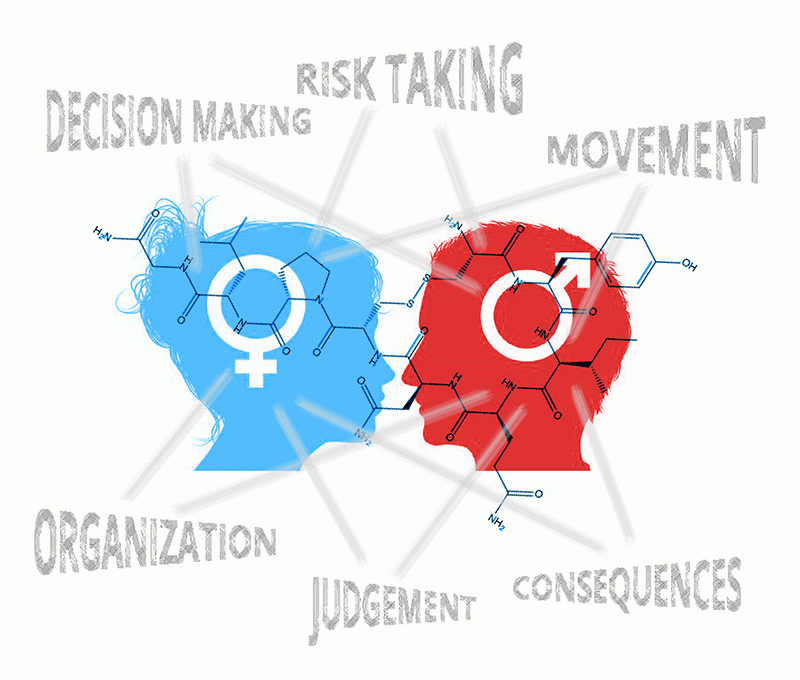
The adolescent brain undergoes several changes that happen in a different order, at a different time, and at a different rate between biological sexes.
Historically, society has segregated people by biological sexual differences. This was the case even as late as the beginning of the 20th century, where co-ed schools had separate entrances for boys and girls, and even taught them in separate classrooms altogether. When Title IX was passed in 1972, the focus was on requiring equal access to all educational activities, regardless of a student’s sex. This shift toward equity in education was monumental, and served as a catalyst for educators and administrators to begin exploring the myriad needs of students and how to support them.
Today, efforts toward equity in education encompass a wide spectrum of considerations including sex, gender identity, socio-economic background, and ethnicity to name a few. Not only are traditional methods of educational delivery evolving, but the learning environment itself is being designed to optimize the positive impact it can have on the academic performance and socio-emotional well-being of a diverse range of learners.
During a recent conversation with representatives from a Seattle-based all-girls school, we were introduced to the theory that there are different teaching strategies for boys and girls at the secondary level*. We were intrigued by the research on hard-wired differences between how boys and girls learn. In particular, the physical and developmental changes that occur in students as they enter adolescence, and the impact this has on how they engage with their environment, their teachers, and their peers. We asked ourselves, how does this translate into design?
Early Adolescence (Ages 10-14)
The move from elementary school to middle school is one of the most difficult academic transitions children make in their lives. On top of that, middle-school kids are in the first stages of adolescence, which is a period when the human brain and body undergo a great amount of change and growth. These changes happen differently from individual to individual and they have an effect on social development, learning, and navigation through the middle school environment.
During the first stages of adolescence, students experience dramatic physical and hormonal changes. These changes have a strong effect on their behavior, thinking, and feelings. For example, as the amount of oxytocin grows, kids start to care about what others think about them and are hesitant to do things differently or things their friends don’t agree with. Another example, as the level of testosterone grows, kids become more likely to take risks and worry less about the consequences. Testosterone also promotes urges for movement, which can result in restlessness if movement is restricted.
In general terms, the adolescent brain undergoes several changes that happen in a different order, at a different time, and at a different rate between biological sexes. In developing toward adulthood, the female teenage brain is approximately two years ahead of the male teenage brain. The prefrontal cortex, which is associated with decision-making, being aware of one’s actions, judgement, and organization, pops into gear for girls. Conversely, for boys during the same stage, these skills are at an all-time low. The corpus callosum, the bundle of nerves that bridges the two halves of the brain, controls complicated language thinking. As this area develops earlier in girls, it helps them become better at written communication, while boys hone this skill in later years.
Different Spatial Needs
Based on the changes that students experience in early adolescence, we can start to identify the different kinds of spaces that might help the ease of these changes. Social-emotional learning in teenagers can be supported or inhibited by aspects of the physical environment.
As girls become more concerned with what others may think about them, they need places where they feel comfortable being themselves. As their decision-making skills develop, they need spaces where they can establish a sense of ownership. As they become more aware of judgement and consequences, they need room to learn how take risks. As their skills for complicated language thinking get better, they need the ability to use language, especially when it comes to social/emotional learning.
Similarly, boys are experiencing an increased desire to explore and investigate, and to exhibit more impulsive decision-making. They need places to develop a sense of independence in this way, but with enough supervision that they stay safe. As higher levels of testosterone run through their bodies, they needs spaces where they can move, test limits, exert energy, and express themselves.
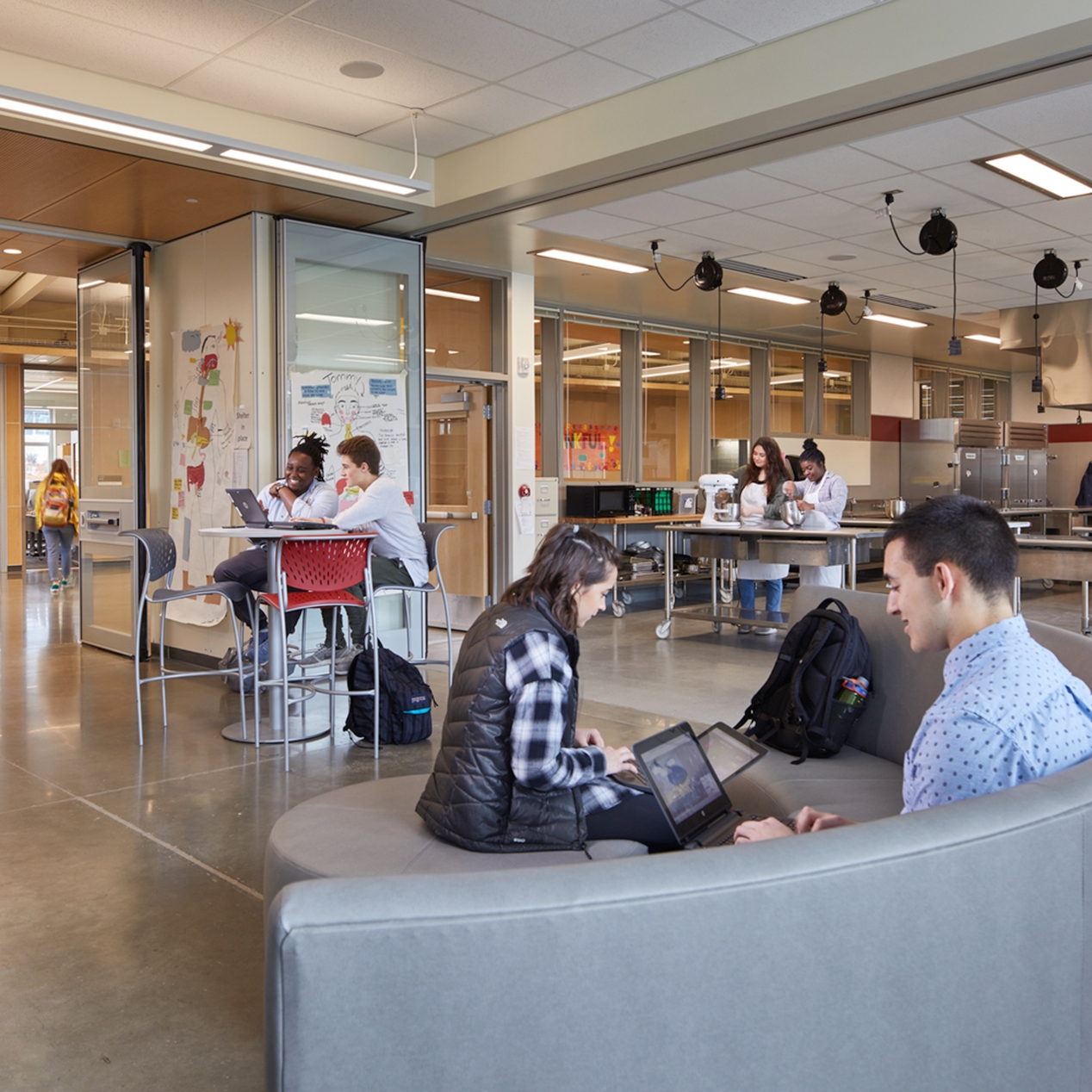
Flexible furniture which accommodates movement can increase boys’ attention span. Wilson High School — NAC Architecture
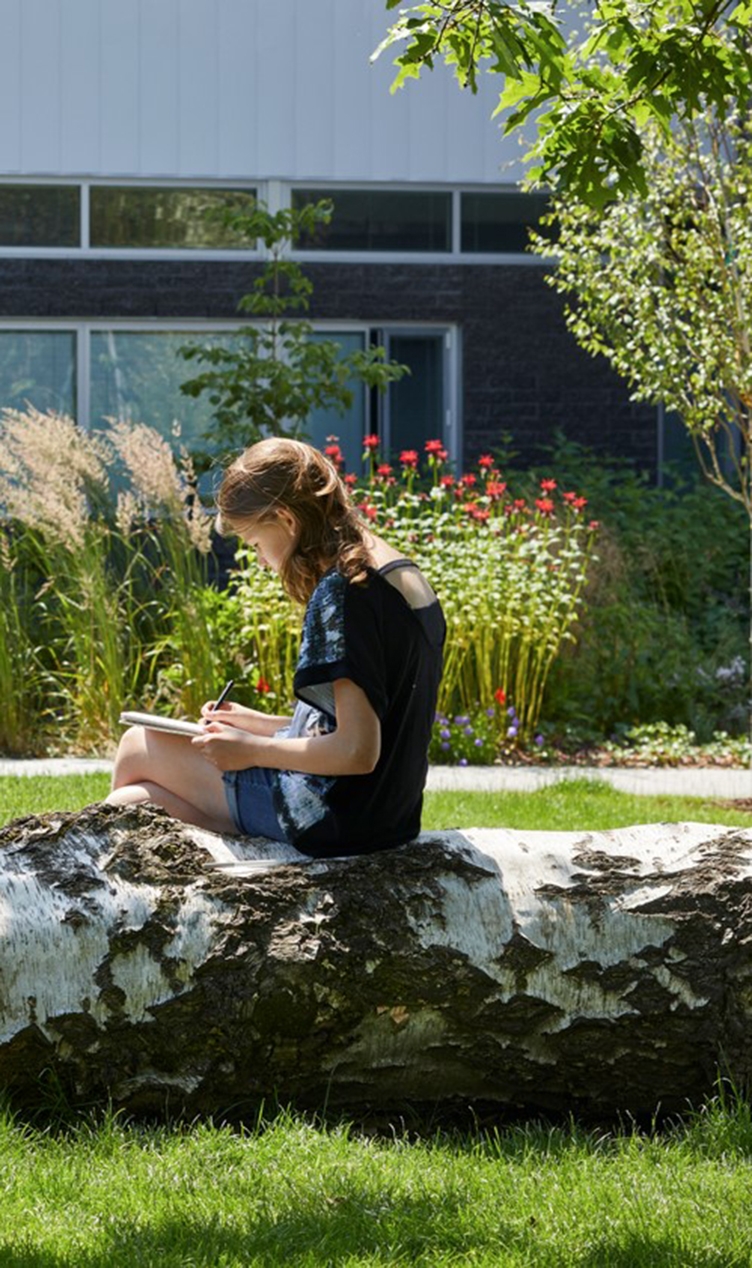
Girls have a greater sensitivity to noise and tend to need quiet places to concentrate. Hazel Wolf K-8 E-STEM School — NAC Architecture
Design Implications
Spaces that support the sharing of ideas in small groups can help anxious adolescents participate and practice their presentation skills. These smaller spaces should have a transparent connection to larger instruction areas to facilitate supervision. In this context, students can be positioned as experts, rewarding them for taking the risk of sharing their information. L-shaped classrooms provide a variety of areas for small groups, while remaining a cohesive space.
Offering multiple pathways and access points to learning spaces can support variety of movement, allowing students to choose the path they are comfortable with, and express themselves through their choices without creating a distraction for others. Mobile and adjustable furniture, in classrooms sized adequately for a variety of configurations, can provide another opportunity to absorb movement and energy, and to promote creativity. Specific amenities such as a climbing wall located in a common area can encourage movement and provide a safe level of risk-taking.
Makerspaces are part of a growing trend to introduce design thinking into educational programming. Although often technology-rich, these spaces should use the most inclusive definition of making. People involved in textile or culinary arts may not identify themselves as makers, or can feel excluded from the maker movement with its emphasis on STEM, but there is plenty of potential for creativity, design, and tinkering in all of these pursuits. First-hand project-based learning, emphasizing process over product and celebrating failure as learning, are strategies that legitimize students’ explorations and reward every individual.
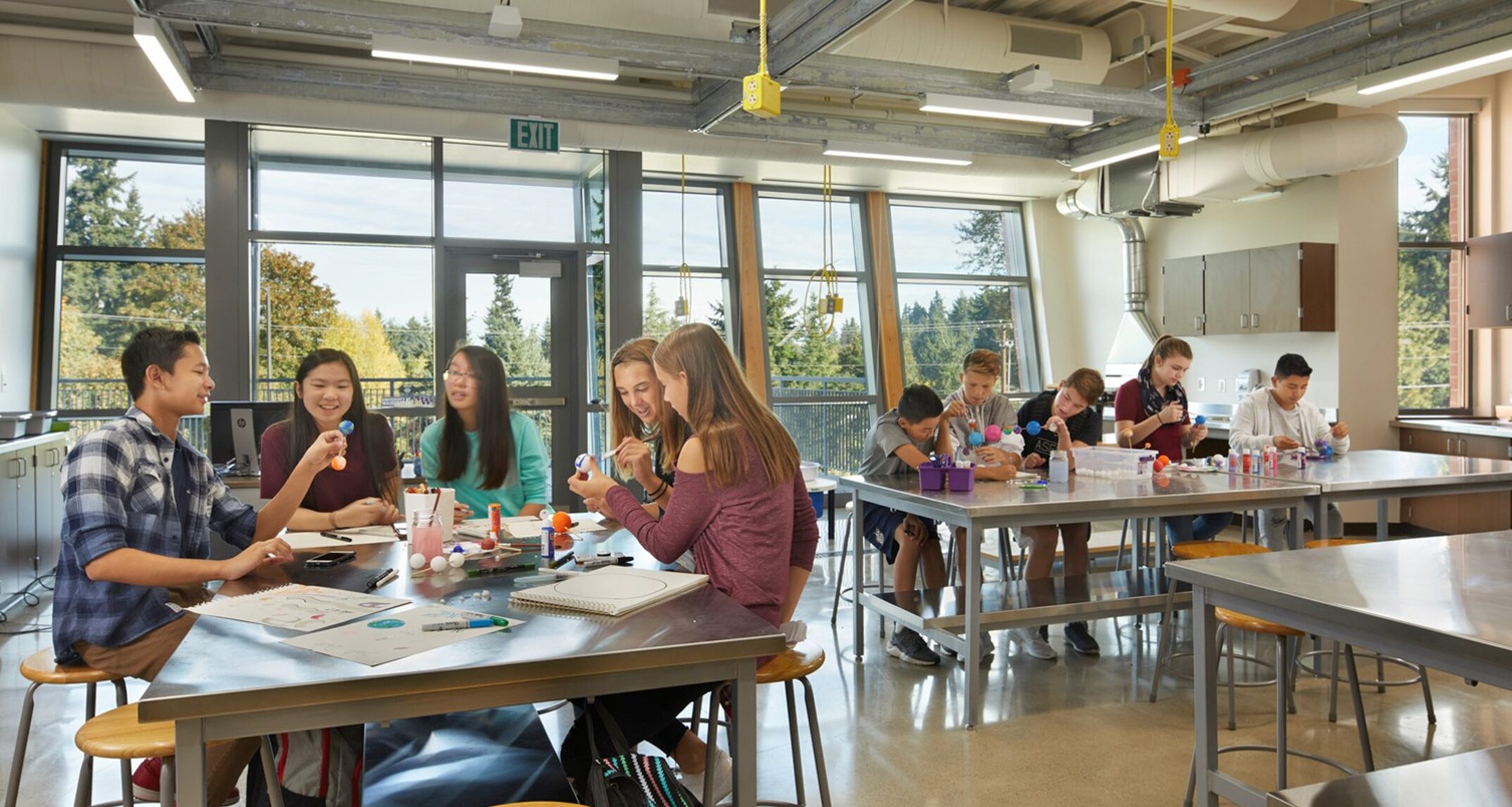
Attractive makerspaces encourage students to explore and take risks by engaging in project-based STEM learning. Risdon Middle School — NAC Architecture
The school lunch experience in a sprawling, noisy cafeteria can be a barrier to comfortable social-emotional development. More variety in the spaces that students occupy while they eat lunch will provide more opportunity for them to connect with their peers and have positive social interactions. At Tillicum Middle School, which will open this fall, the cafeteria provides an assortment of spaces that kids can choose from depending on what they need at the moment. The cafeteria is directly connected to an internal courtyard that can be used as a space for reflection and to an outdoor courtyard that provides more space for movement. On the second floor there’s a balcony that provides kids the opportunity to become observers instead of being in the middle of the action. The library overhangs and protrudes in the cafeteria to create a strong visual connection, giving kids the opportunity to occupy this space if they need quiet and/or study time.
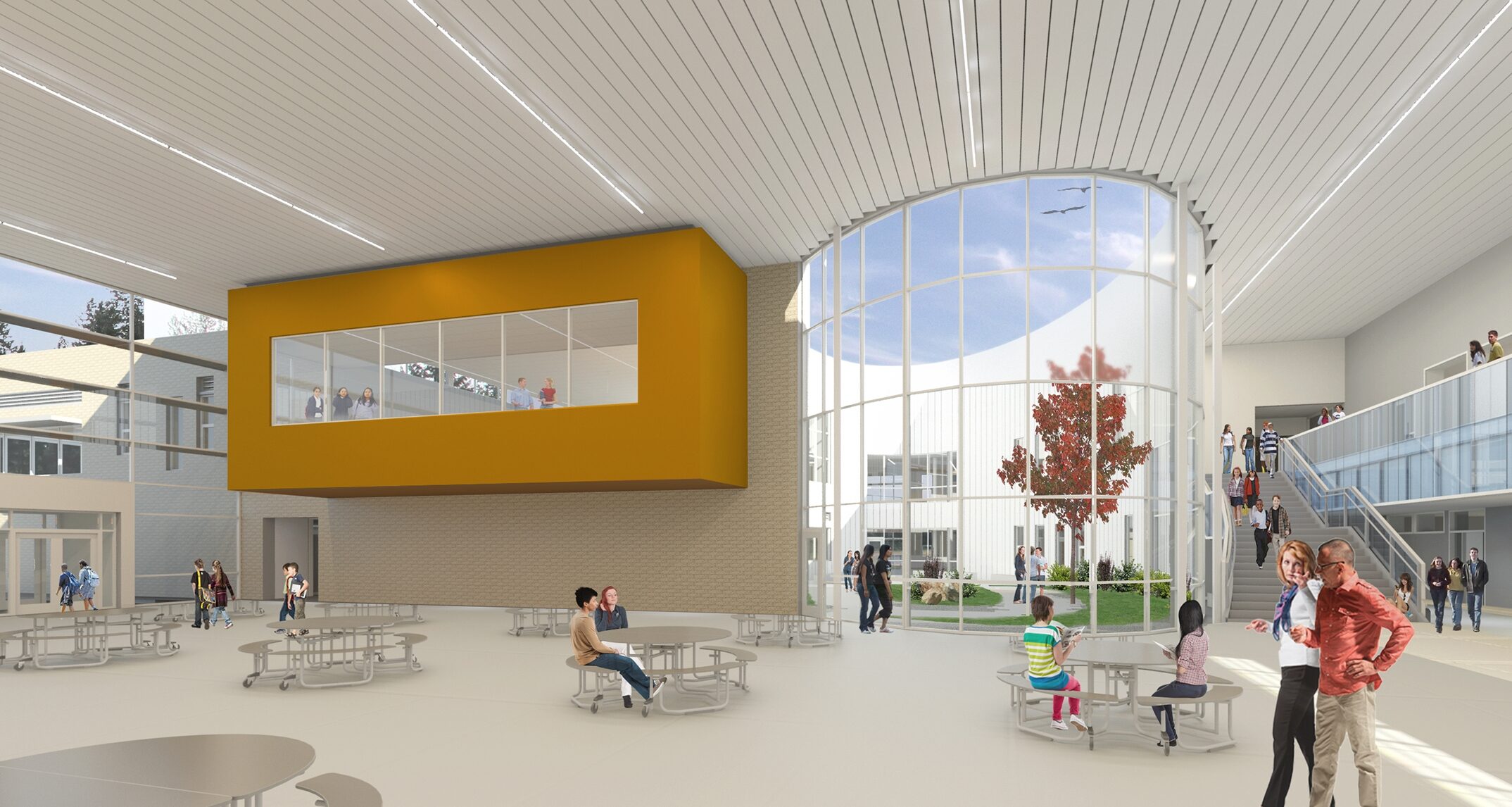
The commons and surrounding spaces at the new Tillicum Middle School will provide a variety of options for students to suit their needs. — NAC Architecture
Conclusion
Early adolescence is a very complicated age. As designers, we need to understand that at this age kids are going through major rapid changes and that these don’t happen at the same rate or in the same way for everybody. To provide true equity in middle schools, we must provide designs that have enough variety to support the growth that happens during early adolescence. And we should recognize that not one solution fits all.
Notes
* We are discussing males and females in this article as averages or aggregates, but these groups are composed of a wide variety of individuals. The general differences we are discussing here reflect the centers of overlapping ranges of each trait, so they do not apply to all individuals in each group. A well-designed and equitably managed school has the potential to support the entire spectrum of gender identity, benefitting all students.
Resources
Deak, JoAnn (2014). Gender Differences. Retrieved from https://www.youtube.com/watch?v=UMT5ANG2HOw
PBS Parents (2018). Understanding Girls’ Brains. Retrieved from http://www.pbs.org/parents/parenting/raising-girls/body-image-identity/ understanding-girls-brains/
Sax, L. (2005). The promise and peril of single-sex public education. Education Week, 24(25), 48. Retrieved from https://www.edweek.org/ew/ articles/2005/03/02/25sax.h24.html
